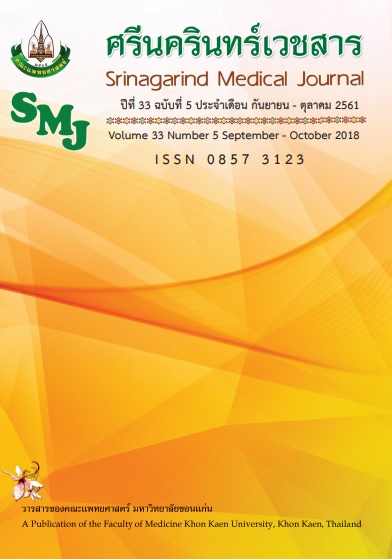Application of STOPP/START Criteria for Screening Inappropriate Medication Using in Elderly Patients with Chronic Diseases
Keywords:
Potentially inappropriate medications, Elderly, STOPP/START criteria, Chronic disease, ที่คำสั่งใช้ยาที่ไม่เหมาะสม, ผู้สูงอายุ, โรคเรื้อรังAbstract
การประยุกต์ใช้เกณฑ์ STOPP/START สำหรับตรวจคัดกรองการใช้ยาที่ไม่เหมาะสมในผู้สูงอายุที่มีโรคเรื้อรัง
อรวดี เพ็งประสพ1*, ขวัญจิต ด่านวิไล2
1ฝ่ายเภสัชกรรม โรงพยาบาลลาดบัวหลวง
2ภาควิชาเภสัชกรรมคลินิก คณะเภสัชศาสตร์ มหาวิทยาลัยนเรศวร
หลักการและวัตถุประสงค์: ผู้สูงอายุที่มีโรคเรื้อรังมักจะมีการใช้ยาหลายชนิดร่วมกัน จึงอาจเสี่ยงต่อการเกิดปัญหาในการใช้ยา หากมีการตรวจคัดกรองคำสั่งใช้ยาของผู้ป่วยโดยใช้เครื่องมือที่มีประสิทธิภาพ จะลดปัญหาการใช้ยาในผู้สูงอายุได้ การศึกษานี้มีวัตถุประสงค์เพื่อตรวจสอบความไม่เหมาะสมของคำสั่งใช้ยาโดยใช้เกณฑ์ screening tool of older people's prescriptions (STOPP) และเกณฑ์ screening tool to alert to right treatment (START) เวอร์ชั่น 2 ที่พัฒนาขึ้นและติดตามการปรับเปลี่ยนคำสั่งใช้ยาภายหลังจากที่เภสัชกรให้คำแนะนำปรึกษากับแพทย์
วิธีการศึกษา: การศึกษานี้มีรูปแบบการวิจัยเชิงทดลองขั้นต้น แบบ One-Shot Case Study ได้พัฒนาเครื่องมือในการคัดกรองคำสั่งใช้ยาที่ไม่เหมาะสมที่ดัดแปลงจากเกณฑ์ STOPP/START จากนั้นนำเครื่องมือที่พัฒนาขึ้นไปตรวจคัดกรองคำสั่งใช้ยาในผู้สูงอายุโรคเรื้อรังอายุตั้งแต่ 65 ปี ขึ้นไปที่มีโรคความดันโลหิตสูง โรคเบาหวาน หรือโรคไตเรื้อรัง ณ โรงพยาบาลลาดบัวหลวง ตั้งแต่วันที่ 1 พฤศจิกายน พ.ศ. 2560 – 1 กุมภาพันธ์ พ.ศ. 2561 เภสัชกรจะให้คำแนะนำปรึกษาแก่แพทย์ในการปรับเปลี่ยนคำสั่งใช้ยาเมื่อพบคำสั่งใช้ยาที่ไม่เหมาะสม และติดตามผลภายหลังการให้คำแนะนำปรึกษา
ผลการศึกษา: เครื่องมือที่พัฒนาขึ้นประกอบด้วยเกณฑ์ STOPP 25 ข้อ และเกณฑ์ START 7 ข้อ ผลการนำไปใช้คัดกรองการใช้ยาที่ไม่เหมาะสมในผู้ป่วย จำนวน 1,181 ราย พบความไม่เหมาะสมตามเกณฑ์ STOPP จำนวน 53 ราย (ร้อยละ 4.49) และความไม่เหมาะสมตามเกณฑ์ START จำนวน 122 ราย (ร้อยละ 10.33) เภสัชกรให้คำแนะนำปรึกษาแก่แพทย์เพื่อเปลี่ยนแปลงคำสั่งยา พบการเปลี่ยนแปลงคำสั่งใช้ยาของแพทย์ตามคำแนะนำของเภสัชกรในเกณฑ์ STOPP จำนวน 31 ราย (ร้อยละ 72.09) และเกณฑ์ START จำนวน 82 ราย (ร้อยละ 73.87) ไม่เปลี่ยนแปลงแต่มีการตระหนักและจัดการแก้ไขปัญหาตามเกณฑ์ STOPP จำนวน 9 ราย (ร้อยละ 20.93) และเกณฑ์ START จำนวน 8 ราย (ร้อยละ 7.21) และไม่มีการเปลี่ยนแปลงใดๆ ตามเกณฑ์ STOPP จำนวน 3 ราย (ร้อยละ6.98) และเกณฑ์ START จำนวน 21 ราย (ร้อนละ 18.92)
สรุป: เครื่องมือที่ดัดแปลงจากเกณฑ์ STOPP/START สามารถคัดกรองคำสั่งใช้ยาที่ไม่เหมาะสมและส่วนใหญ่แพทย์จะปรับเปลี่ยนคำสั่งใช้ยาตามการให้คำแนะนำปรึกษาของเภสัชกร
Background and Objectives: Elderly patients with chronic diseases often use many medications, can cause drug related problem. If medication orders are reviewed by effective tool therefore it could reduce drug related problems. The aims of this study were to explore the potentially inappropriate medications (PIM) by using a screening tool of older people's prescriptions (STOPP) and screening tool to alert to right treatment (START) version 2. and the result of medication orders change after pharmacists consult physicians.
Methods: This was a pre-experimental study. We developed tools for screening PIM from STOPP/START criteria. Data were collected in elderly patients with chronic diseases who aged ≥ 65 years with high blood pressure, diabetes or chronic kidney diseases at Latbualuang hospital from 1 November 2017 to 1 February 2018. When pharmacists find an inappropriate medication orders, will consult physicians and collect the effect after that.
Results: We developed a screening tool adapted from STOPP 25 items and START 7 items. There were 1,181 patients participated in the study. STOPP criteria can detect PIM in 53 patients (4.49%) and 122 patients (10.33%) by START criteria and then pharmacists consult physicians to change the medication order. Physicians accept to change the order in 31 patients (72.09%) identified by STOPP criteria and accepted in 82 patients (73.87%) identified by START criteria. Physicians did not change orders but revise order in 9 patients (20.93%) by STOPP criteria and 8 patients (7.21%) by START criteria and physician did not change order in 3 patients (6.98%) by STOPP criteria and 21 patients (18.92%) by START criteria.
Conclusion: This tool adapted from STOPP/START criteria can screen for PIM. Almost physicians changed orders according to pharmacist’s suggestion.
References
Department of Economic and Social Affairs. World Population Ageing 2015 - Highlights. New York: 2015.
มูลนิธิสถาบันวิจัยและพัฒนาผู้สูงอายุไทย (มส.ผส.). สถานการณ์ผู้สูงอายุไทย พ.ศ. 2557 [อินเตอร์เน็ต]. 2557 [เข้าถึงเมื่อ 19 มกราคม 2559].เข้าถึงได้จาก: http://thaitgri.org/?wpdmdl=36742.
มูลนิธิสถาบันวิจัยและพัฒนาผู้สูงอายุไทย. สถานการณ์ผู้สูงอายุไทยพ.ศ. 2552. พิมพ์ครั้งที่ 1.บริษัททีคิวพีจำกัด; 2553.
มูลนิธิสถาบันวิจัยและพัฒนาผู้สูงอายุไทย (มส.ผส.). สถานการณ์ผู้สูงอายุไทย พ.ศ. 2560 [อินเตอร์เน็ต]. 2560 [เข้าถึงเมื่อ 12 มีนาคม 25561].เข้าถึงได้จาก: http://thaitgri.org/?p=38427.
Bahat G, Tufan F, Akin S, Tufan A, Erten N, Karan MA. Rational Drug Use in the Elderly. J Gerontol Geriat Res 2012; 1: 1-5
Budnitz DS, Lovegrove MC, Shehab N, Richards CL. Emergency hospitalizations for adverse drug events in older Americans. N Engl J Med 2011; 365: 2002-12.
Wooten JM. Pharmacotherapy considerations in elderly adults. South Med J 2012; 105: 437-45.
Page RL, II SAL, Bryant LL, Ruscin JM. Inappropriate prescribing in the hospitalized elderly patient: defining the problem, evaluation tools, and possible solutions. Clin Interv Aging 2010; 5: 75-87.
ชาญกิจ พุฒิเลอพงศ์. การใช้ยาอย่างสมเหตุผลในผู้สูงอายุ. ใน: เวชศาสตร์ร่วมสมัย 2015. กรุงเทพฯ: พี.เอ.ลีฟวิ่ง; 2558: 308-16.
O'mahony D, O'sullivan D, Byrne S, O'connor MN, Ryan C, Gallagher P. STOPP/START criteria for potentially inappropriate prescribing in older people: version 2. Age Ageing 2015; 44: 213-8.
Panel AGSBCUE, Fick DM, Semla TP, Beizer J, Brandt N, Dombrowski R, et al. American Geriatrics Society 2015 updated beers criteria for potentially inappropriate medication use in older adults. J Am Geriatr Soc 2015; 63: 2227-46.
Gallagher P, O’Mahony D. STOPP (Screening Tool of Older Persons’ potentially inappropriate Prescriptions): application to acutely ill elderly patients and comparison with Beers’ criteria. Age Ageing 2008; 37: 673-9.
Limpawattana P, Kamolchai N, Theeranut A, Pimporm J. Potentially inappropriate prescribing of Thai older adults in an internal medicine outpatient clinic of a tertiary care hospital. Afr J Pharm Pharmacol 2013; 7(34): 2417-22.
Nagendra Vishwas H, Harugeri A, Parthasarathi G, Ramesh M. Potentially inappropriate medication use in Indian elderly: comparison of Beers' criteria and Screening Tool of Older Persons' potentially inappropriate Prescriptions. Geriatr Gerontol Int 2012; 12: 506-14.
Ubeda A, Ferrándiz L, Maicas N, Gómez C, Bonet M, Peris JE. Potentially inappropriate prescribing in institutionalised older patients in Spain: the STOPP-START criteria compared with the Beers criteria. Pharm Pract 2012; 10: 83-91.
Ryan C, O'mahony D, Kennedy J, Weedle P, Byrne S. Potentially inappropriate prescribing in an Irish elderly population in primary care. Br J Clin Pharmacol 2009; 68: 936-47.
López NP, Villán YFV, Menéndez MIG, Royuela A. Prescripción potencialmente inapropiada en mayores de 65 años en un centro de salud de atención primaria. Atención Primaria 2014; 46: 290-7.
Ryan C, O’Mahony D, O’Donovan DÓ, O’Grady E, Weedle P, Kennedy J, et al. A comparison of the application of STOPP/START to patients’ drug lists with and without clinical information. Int J Clin Pharm 2013; 35: 230-5.
Lozano-Montoya I, Vélez-Diaz-Pallarés M, Delgado-Silveira E, Montero-Errasquin B, Cruz Jentoft AJ. Potentially inappropriate prescribing detected by STOPP–START criteria: are they really inappropriate? Age Ageing 2015; 44: 861-6.


